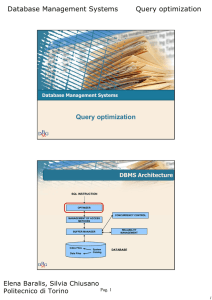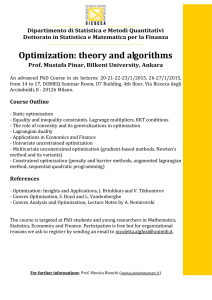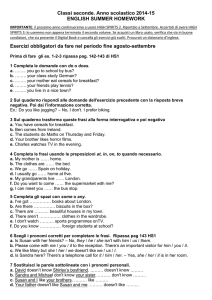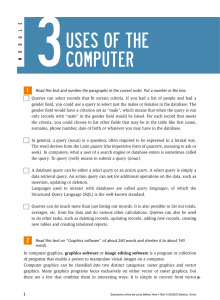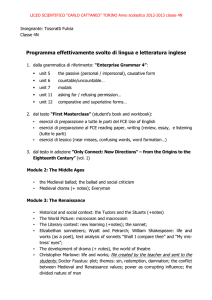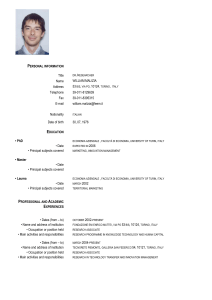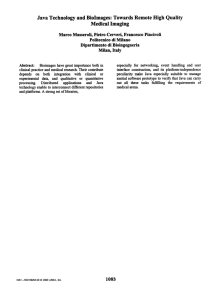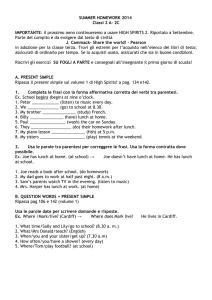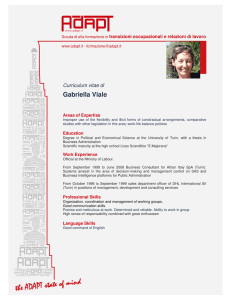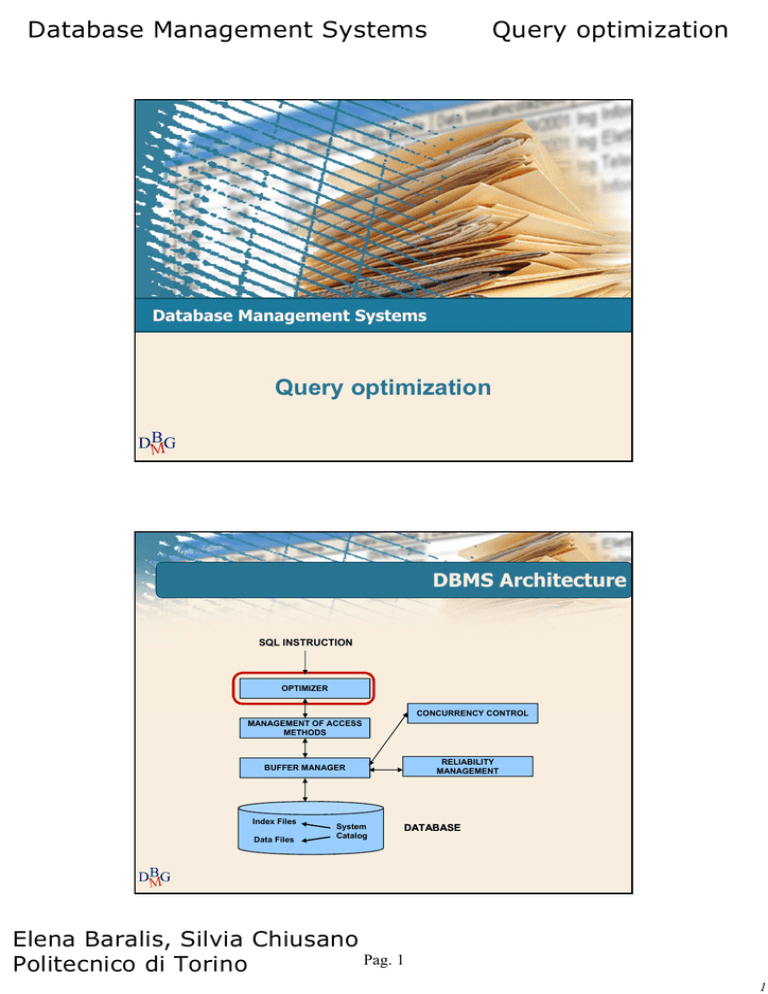
Database Management Systems
Query optimization
Database Management Systems
Query optimization
DB
MG
DBMS Architecture
SQL INSTRUCTION
OPTIMIZER
CONCURRENCY CONTROL
MANAGEMENT OF ACCESS
METHODS
RELIABILITY
MANAGEMENT
BUFFER MANAGER
Index Files
Data Files
System
Catalog
DATABASE
DB
MG
Elena Baralis, Silvia Chiusano
Pag. 1
Politecnico di Torino
1
Database Management Systems
Query optimization
Query optimizer
It selects an efficient strategy for query execution
It is a fundamental building block of a relational
DBMS
It guarantees the data independence property
The form in which the SQL query is written does
not affect the way in which it is implemented
A physical reorganization of data does not require
rewriting SQL queries
3
DB
MG
Query optimizer
It automatically generates a query execution plan
It was formerly hard-coded by a programmer
The automatically generated execution plan is
usually more efficient
It evaluates many different alternatives
It exploits statistics on data, stored in the system
catalog, to make decisions
It exploits the best known strategies
It dynamically adapts to changes in the data
distribution
DB
MG
4
Elena Baralis, Silvia Chiusano
Pag. 2
Politecnico di Torino
2
Database Management Systems
Query optimization
Query optimizer
SQL
QUERY
LEXICAL, SYNTACTIC
AND SEMANTIC
ANALYSIS
DB
MG
Lexical, syntactic and semantic analysis
Analysis of a statement to detect
Lexical errors
e.g., misspelled keywords
Syntactic errors
errors in the grammar of the SQL language
Semantic errors
references to objects which do not actually exist in
the database (e.g, attributes or tables)
information in the data dictionary is needed
DB
MG
6
Elena Baralis, Silvia Chiusano
Pag. 3
Politecnico di Torino
3
Database Management Systems
Query optimization
Lexical, syntactic and semantic analysis
Output
Internal representation in (extended) relational
algebra
Why relational algebra?
It explicitly represents the order in which operators
are applied
It is procedural (different from SQL)
There is a corpus of theorems and properties
exploited to modify the initial query tree
7
DB
MG
Query optimizer
SQL
QUERY
LEXICAL, SYNTACTIC
AND SEMANTIC
ANALYSIS
DATA
DICTIONARY
INTERNAL REPRESENTATION
BASED ON RELATIONAL ALGEBRA
ALGEBRAIC
OPTIMIZATION
DB
MG
Elena Baralis, Silvia Chiusano
Pag. 4
Politecnico di Torino
4
Database Management Systems
Query optimization
Algebraic optimization
Execution of algebraic transformations
considered to be always beneficial
Example: anticipation of selection with respect to
join
Should eliminate the difference among different
formulations of the same query
This step is usually independent of the data
distribution
Output
Query tree in “canonical” form
9
DB
MG
Query optimizer
SQL
QUERY
LEXICAL, SYNTACTIC
AND SEMANTIC
ANALYSIS
DATA
DICTIONARY
INTERNAL REPRESENTATION
BASED ON RELATIONAL ALGEBRA
ALGEBRAIC
OPTIMIZATION
“CANONICAL” QUERY TREE
COST BASED
OPTIMIZATION
DB
MG
Elena Baralis, Silvia Chiusano
Pag. 5
Politecnico di Torino
5
Database Management Systems
Query optimization
Cost based optimization
Selection of the “best” execution plan by
evaluating execution cost
Selection of
the best access method for each table
the best algorithm for each relational operator
among available alternatives
Based on a cost model for access methods and
algorithms
Generation of the code implementing the best
strategy
11
DB
MG
Cost based optimization
Output
Access program in executable format
It exploits the internal structures of the DBMS
Set of dependencies
conditions on which the validity of the query plan
depends
e.g., the existence of an index
DB
MG
12
Elena Baralis, Silvia Chiusano
Pag. 6
Politecnico di Torino
6
Database Management Systems
Query optimization
Query optimizer
SQL
QUERY
LEXICAL, SYNTACTIC
AND SEMANTIC
ANALYSIS
DATA
DICTIONARY
INTERNAL REPRESENTATION
BASED ON RELATIONAL ALGEBRA
ALGEBRAIC
OPTIMIZATION
“CANONICAL” QUERY TREE
DATA PROFILES
(STATISTICS ON
DATA)
COST BASED
OPTIMIZATION
DB
MG
ACCESS PROGRAM
SET OF DEPENDENCIES
Execution modes
Compile and go
Compilation and immediate execution of the
statement
No storage of the query plan
Dependencies are not needed
DB
MG
14
Elena Baralis, Silvia Chiusano
Pag. 7
Politecnico di Torino
7
Database Management Systems
Query optimization
Execution modes
Compile and store
The access plan is stored in the database together
with its dependencies
It is executed on demand
It should be recompiled when the data structure
changes
15
DB
MG
Database Management Systems
Algebraic optimization
DB
MG
Elena Baralis, Silvia Chiusano
Pag. 8
Politecnico di Torino
8
Database Management Systems
Query optimization
Algebraic optimization
SQL
QUERY
LEXICAL, SYNTACTIC
AND SEMANTIC
ANALYSIS
DATA
DICTIONARY
INTERNAL REPRESENTATION
BASED ON RELATIONAL ALGEBRA
ALGEBRAIC
OPTIMIZATION
“CANONICAL” QUERY TREE
COST BASED
OPTIMIZATION
DB
MG
ACCESS PROGRAM
DATA PROFILES
(STATISTICS ON
DATA)
SET OF DEPENDENCIES
Algebraic optimization
It is based on equivalence transformations
Two relational expressions are equivalent if they
both produce the same query result for any
arbitrary database instance
Interesting transformations
reduce the size of the intermediate result to be
stored in memory
prepare an expression for the application of a
transformation which reduces the size of the
intermediate result
DB
MG
18
Elena Baralis, Silvia Chiusano
Pag. 9
Politecnico di Torino
9
Database Management Systems
Query optimization
Transformations
1. Atomization of selection
σF1 Ʌ F2 (E) ≡ σF2 (σF1 (E)) ≡ σF1 (σF2 (E))
19
DB
MG
Transformations
1. Atomization of selection
σF1 Ʌ F2 ≡ σF2 (σF1 (E)) ≡ σF1 (σF2 (E))
2. Cascading projections
πX(E) ≡ πX (πX,Y(E))
DB
MG
20
Elena Baralis, Silvia Chiusano
Pag. 10
Politecnico di Torino
10
Database Management Systems
Query optimization
Transformations
1. Atomization of selection
σF1 Ʌ F2 ≡ σF2 (σF1 (E)) ≡ σF1 (σF2 (E))
2. Cascading projections
πX(E) ≡ πX (πX,Y(E))
3. Anticipation of selection with respect to join
(pushing selection down)
σF (E1
E2) ≡ E1
(σF (E2))
F is a predicate on attributes in E2 only
21
DB
MG
Transformations
4. Anticipation of projection with respect to join
πL(E1
p E2)
≡ πL ((πL1, J(E1)
p(πL2,J(E2)))
L1 = L - Schema(E2)
L2 = L - Schema(E1)
J = set of attributes needed to evaluate join
predicate p
DB
MG
22
Elena Baralis, Silvia Chiusano
Pag. 11
Politecnico di Torino
11
Database Management Systems
Query optimization
Transformations
5. Join derivation from Cartesian product
σF (E1 × E2 ) ≡ E1
F E2
predicate F only relates attributes in E1 and E2
23
DB
MG
Transformations
5. Join derivation from Cartesian product
σF (E1 × E2 ) ≡ E1
F E2
predicate F only relates attributes in E1 and E2
6. Distribution of selection with respect to union
σF(E1 ∪ E2 ) ≡ (σF (E1) ) ∪ (σF (E2) )
DB
MG
24
Elena Baralis, Silvia Chiusano
Pag. 12
Politecnico di Torino
12
Database Management Systems
Query optimization
Transformations
5. Join derivation from Cartesian product
σF (E1 × E2 ) ≡ E1
F E2
predicate F only relates attributes in E1 and E2
6. Distribution of selection with respect to union
σF(E1 ∪ E2 ) ≡ (σF (E1) ) ∪ (σF (E2) )
7. Distribution of selection with respect to
difference
σF(E1 – E2) ≡ (σF (E1) ) – (σF (E2) )
≡ (σF (E1)) – E2
25
DB
MG
Transformations
8. Distribution of projection with respect to union
πX(E1 ∪ E2) ≡ (πX(E1)) ∪ (πX(E2))
DB
MG
26
Elena Baralis, Silvia Chiusano
Pag. 13
Politecnico di Torino
13
Database Management Systems
Query optimization
Transformations
8. Distribution of projection with respect to union
πX(E1 ∪ E2) ≡ (πX(E1)) ∪ (πX(E2))
Can projection be distributed with respect to
difference?
πX (E1 - E2) ≡ (πX(E1)) - (πX(E2))
27
DB
MG
Transformations
8. Distribution of projection with respect to union
πX(E1 ∪ E2) ≡ (πX(E1)) ∪ (πX(E2))
Can projection be distributed with respect to
difference?
πX (E1 - E2) ≡ (πX(E1)) - (πX(E2))
This equivalence only holds if X includes the
primary key or a set of attributes with the same
properties (unique and not null)
DB
MG
28
Elena Baralis, Silvia Chiusano
Pag. 14
Politecnico di Torino
14
Database Management Systems
Query optimization
Transformations
9. Other properties
σF1 V F2(E) ≡ (σF1 (E)) ∪ (σF2 (E))
σF1 Ʌ F2(E) ≡ (σF1 (E)) ∩ (σF2 (E))
29
DB
MG
Transformations
10. Distribution of join with respect to union
E
(E1 ∪ E2) ≡ (E
E1) ∪ (E
E2)
All Binary operators are commutative and
associative except for difference
DB
MG
30
Elena Baralis, Silvia Chiusano
Pag. 15
Politecnico di Torino
15
Database Management Systems
Query optimization
Example
Tables
EMP (Emp#, ………, Dept#, Salary)
DEPT (Dept#, DName,……………)
SQL query
SELECT DISTINCT DName
FROM EMP, DEPT
WHERE EMP.Dept#=DEPT.Dept#
AND Salary > 1000;
31
DB
MG
Example: Algebraic transformations
πDName (σEMP.Dept#=DEPT.Dept# Ʌ Salary
DB
MG
>1000
(EMP × DEPT))
32
Elena Baralis, Silvia Chiusano
Pag. 16
Politecnico di Torino
16
Database Management Systems
Query optimization
Example: Algebraic transformations
πDName (σEMP.Dept#=DEPT.Dept# Ʌ Salary
>1000
(EMP × DEPT))
Prop #1
πDName(σSalary >1000 (σEMP.Dept#=DEPT.Dept# (EMP×DEPT))
33
DB
MG
Example: Algebraic transformations
πDName (σEMP.Dept#=DEPT.Dept# Ʌ Salary
>1000
(EMP × DEPT))
Prop #1
πDName(σSalary >1000 (σEMP.Dept#=DEPT.Dept# (EMP×DEPT))
Prop #5
πDName(σSalary >1000 (EMP
DB
MG
DEPT)
34
Elena Baralis, Silvia Chiusano
Pag. 17
Politecnico di Torino
17
Database Management Systems
Query optimization
Example: Algebraic transformations
πDName(σSalary >1000 (EMP
DEPT)
Prop #3
πDName(σSalary >1000 (EMP))
DEPT)
35
DB
MG
Example: Algebraic transformations
πDName(σSalary >1000 (EMP
DEPT)
Prop #3
πDName(σSalary >1000 (EMP))
DEPT)
Prop #2 and #4
πDName ((πDept# (σSalary >1000(EMP))
DB
MG
(πDept#,DName(DEPT)))
36
Elena Baralis, Silvia Chiusano
Pag. 18
Politecnico di Torino
18
Database Management Systems
Query optimization
Example: Query tree
Final query tree
πDName
πDept#
πDept#,DName
σSalary>1000 DEPT
EMP
37
DB
MG
Example: Cardinalities
Cardinality (EMP) ≈ 10,000
Cardinality (DEPT) ≈ 100
Cardinality (EMP where Salary > 1000) ≈ 50
DB
MG
38
Elena Baralis, Silvia Chiusano
Pag. 19
Politecnico di Torino
19
Database Management Systems
Query optimization
Database Management Systems
Cost based optimization
DB
MG
Cost based optimization
SQL
QUERY
LEXICAL, SYNTACTIC
AND SEMANTIC
ANALYSIS
DATA
DICTIONARY
INTERNAL REPRESENTATION
BASED ON RELATIONAL ALGEBRA
ALGEBRAIC
OPTIMIZATION
“CANONICAL” QUERY TREE
COST BASED
OPTIMIZATION
DB
MG
ACCESS PROGRAM
DATA PROFILES
(STATISTICS ON
DATA)
SET OF DEPENDENCIES
Elena Baralis, Silvia Chiusano
Pag. 20
Politecnico di Torino
20
Database Management Systems
Query optimization
Cost based optimization
It is based on
Data profiles
statistical information describing data distribution for
tables and intermediate relational expressions
Approximate cost formulas for access operations
Allow evaluating the cost of different alternatives for
executing a relational operator
DB
MG
Database Management Systems
Data processing modes
DB
MG
Elena Baralis, Silvia Chiusano
Pag. 21
Politecnico di Torino
21
Database Management Systems
Query optimization
Transaction processing
On Line Transaction Processing (OLTP)
Traditional DBMS usage
Characterized by
snapshot of current data values
detailed data, relational representation
structured, repetitive operations
read/write access to few records
short transactions
isolation, reliability, and integrity are critical (ACID)
database size ≈ 100MB-GB
43
DB
MG
Analytical processing
On Line Analytical Processing (OLAP)
Decision support applications
Characterized by
“historical” data
consolidated, integrated data
ad hoc applications
read access to millions of records
complex queries
consistency before and after periodical loads
database size ≈ 100GB-TB
DB
MG
44
Elena Baralis, Silvia Chiusano
Pag. 22
Politecnico di Torino
22
Database Management Systems
Query optimization
Database Management Systems
Data profiles
DB
MG
Table profiles
Quantitative information on the characteristics of
tables and columns
cardinality (# of tuples) in each table T
also estimated for intermediate relational
expressions
size in bytes of tuples in T
size in bytes of each attribute Aj in T
number of distinct values of each attribute in T
cardinality of the active domain of the attribute
min and max values of each attribute Aj in T
DB
MG
46
Elena Baralis, Silvia Chiusano
Pag. 23
Politecnico di Torino
23
Database Management Systems
Query optimization
Table profiles
Table profiles are stored in the data dictionary
Profiles should be periodically refreshed by reanalyzing data in the tables
Update statistics command
Executed on demand
immediate execution during transaction processing
would overload the system
47
DB
MG
Data profiles
Table profiles are exploited to estimate the size
of intermediate relational expressions
For the selection operator
Card (σAi = v (T)) ≈ Card (T)/ Val (Ai in T)
Val (Ai in T) = # of distinct values of Ai in T (active
domain)
It holds only under the hypothesis of uniform
distribution
DB
MG
48
Elena Baralis, Silvia Chiusano
Pag. 24
Politecnico di Torino
24
Database Management Systems
Query optimization
Database Management Systems
Access operators
DB
MG
Query tree
Internal representation of the relational
expression as a query tree
πDName
πDept#
πDept#,DName
σSalary>1000 DEPT
EMP
DB
MG
50
Elena Baralis, Silvia Chiusano
Pag. 25
Politecnico di Torino
25
Database Management Systems
Query optimization
Query tree
Leaves correspond to the physical structures
tables, indices
Intermediate nodes are operations on data
supported by the given physical structure
e.g., scan, join, group by
51
DB
MG
Sequential scan
Executes sequential access to all tuples in a table
also called full table scan
Operations performed during a sequential scan
Projection
discards unnecessary columns
Selection on a simple predicate (Ai=v)
Sorting based on an attribute list
Insertion, update, delete
DB
MG
52
Elena Baralis, Silvia Chiusano
Pag. 26
Politecnico di Torino
26
Database Management Systems
Query optimization
Sorting
Classical algorithms in computer science are
exploited
e.g., quick sort
Size of data is relevant
memory sort
sort on disk
53
DB
MG
Predicate evaluation
If available, it may exploit index access
B+-tree, hash, or bitmap
Simple equality predicate Ai=v
Hash, B+-tree, or bitmap are appropriate
Range predicate v1 ≤ Ai ≤ v2
only B+-tree is appropriate
For predicates with limited selectivity full table
scan is better
if available, consider bitmap
DB
MG
54
Elena Baralis, Silvia Chiusano
Pag. 27
Politecnico di Torino
27
Database Management Systems
Query optimization
B+-tree versus bitmap
Bitmap VS B-Tree
600
Disk space (MB)
500
400
300
200
100
0
0
5
10
15
20
25
30
35
40
45
NK
B-Tree
B-tree
Bitmap
Bitmap
NR×Len(Pointer)
NR × NK × 1 bit
Len(Pointer) = 4×8 bit
DB
MG
Courtesy of Golfarelli, Rizzi,
”Data warehouse, teoria e
pratica della progettazione”,
55
McGraw Hill 2006
Predicate evaluation
Conjunction of predicates Ai= v1 Ʌ Aj= v2
The most selective predicate is evaluated first
Table is read through the index
Next the other predicates are evaluated on the
intermediate result
Optimization
First compute the intersection of bitmaps or RIDs
coming from available indices
Next table read and evaluation of remaining
predicates
DB
MG
56
Elena Baralis, Silvia Chiusano
Pag. 28
Politecnico di Torino
28
Database Management Systems
Query optimization
Example: Predicate evaluation
Which female students living in Piemonte are
exempted from enrollment fee?
RID
Gender
Exempted
Region
1
M
Y
Piemonte
2
F
Y
Liguria
3
M
N
Puglia
4
M
N
Sicilia
Gender
Exempted
Piemonte
5
F
Y
Piemonte
0
1
1
1
1
0
0
0
0
0
0
0
1
1
1
DB
MG
RID 5
57
Predicate evaluation
Disjunction of predicates Ai= v1 V Aj= v2
Index access can be exploited only if all predicates
are supported by an index
otherwise full table scan
DB
MG
58
Elena Baralis, Silvia Chiusano
Pag. 29
Politecnico di Torino
29
Database Management Systems
Query optimization
Join operation
A critical operation for a relational DBMS
connection between tables is based on values
instead of pointers
size of the intermediate result is typically larger
than the smaller table
Different join algorithms
Nested loop
Merge scan join
Hash join
Bitmapped join
59
DB
MG
Nested loop
Inner table
Outer table
A
A
external
scan
a
a
internal
or direct scan
DB
MG
a
join
attribute
a
60
Elena Baralis, Silvia Chiusano
Pag. 30
Politecnico di Torino
30
Database Management Systems
Query optimization
Nested loop
A single full scan is done on the outer table
For each tuple in the outer table
a full scan of the inner table is performed, looking
for corresponding values
Also called “brute force”
61
DB
MG
Nested loop
Efficient when
inner table is small and fits in memory
optimized scan
join attribute in the inner table is indexed
index scan
Execution cost
The nested loop join technique is not symmetric
The execution cost depends on which table takes
the role of inner table
DB
MG
62
Elena Baralis, Silvia Chiusano
Pag. 31
Politecnico di Torino
31
Database Management Systems
Query optimization
Merge scan
Left table
A
a
left
scan
right
scan
Right table
A
a
b
d
b
b
c
e
e
join
attribute
DB
MG
63
Merge scan
Both tables are sorted on the join attributes
The two tables are scanned in parallel
tuple pairs are generated on corresponding values
Execution cost
The merge scan technique is symmetric
requires sorting both tables
may be sorted by a previous operation
may be read through a clustered index on join
attributes
More used in the past
DB
MG
efficient for large tables, because sorted tables
may be stored on disk
64
Elena Baralis, Silvia Chiusano
Pag. 32
Politecnico di Torino
32
Database Management Systems
Query optimization
Hash Join
From
left table
HASH(a)
DB
MG
Buckets for
left table
Buckets for
right table
d
e
e
m
a
c
a
w
j
p
j
z
From
right table
HASH(a)
Join
Attribute
65
Hash join
Application of the same hash function to the join
attributes in both tables
Tuples to be joined end up in the same buckets
collisions are generated by tuples yielding the same
hash function result with different attribute value
A local sort and join is performed into each bucket
Very fast join technique
DB
MG
66
Elena Baralis, Silvia Chiusano
Pag. 33
Politecnico di Torino
33
Database Management Systems
Query optimization
Bitmapped join index
Bit matrix that precomputes the join between
two tables A and B
One column for each RID in table A
One row for each RID in table B
Position (i, j) of the matrix is
1 if tuple with RID i in table A joins with tuple with
RID j in table B
RID
1
2
…
n
0 otherwise
1
0
0
…
1
Updates may be slow
DB
MG
2
0
1
…
0
3
0
0
…
1
4
1
0
…
0
…
…
…
…
0
67
Bitmapped join
Typically used in OLAP queries
joining several tables with a large central table
Example
Exam table, joined to Student and Course tables
Exploits one or more bitmapped join indices
One for each pair of joined tables
Access to the large central table is the last step
DB
MG
68
Elena Baralis, Silvia Chiusano
Pag. 34
Politecnico di Torino
34
Database Management Systems
Query optimization
Bitmapped join
Complex queries may exploit jointly
bitmapped join indices
bitmap indices for predicates on single tables
69
DB
MG
Example: Bitmapped join
Average score of male students for exams of
courses in the first year of the master degree
STUDENT (Reg#, SName, Gender)
COURSE (Course#, CName, CourseYear)
EXAM (Reg#, Course#, Date, Grade)
SELECT AVG (Grade)
FROM STUDENT S, EXAM E, COURSE C
WHERE E.Reg# = S.Reg#
AND E.Course# = C.Course#
AND CourseYear = ‘1M’
AND Gender = ‘M’;
DB
MG
70
Elena Baralis, Silvia Chiusano
Pag. 35
Politecnico di Torino
35
Database Management Systems
Query optimization
Bitmapped join
… FROM EXAM E, COURSE C
WHERE E.Course# = C.Course#
AND CourseYear = ‘1M’ …
Bitmap for CourseYear attribute
RID
…
1M
…
…
1
0
1
…
0
2
0
0
…
0
3
0
0
…
1
4
0
1
…
0
5
1
0
…
0
RIDs 1 and 4
Bitmapped join index
for Course-Exams join
RID
1
…
4
…
1
0
…
1
1
1
4
RIDCY
2
0
…
1
0
0
1
1
3
0
…
0
1
0
4
1
…
0
0
0
0
0
…
…
…
…
…
1
0
1
…
…
…
DB
MG
OR
1
1
=
Bitmapped join
RIDCY
RIDG
RID
1
1
1
1
0
AND
0
0
=
0
0
1
1
1
…
…
…
bitmap for Course-Exam
predicates and join
RIDs of Exam table
for tuples to be read
bitmap for Student-Exam
predicates and join
DB
MG
Elena Baralis, Silvia Chiusano
Pag. 36
Politecnico di Torino
36
Database Management Systems
Query optimization
Group by
Sort based
Sort on the group by attributes
Next compute aggregate functions on groups
Hash based
Hash function on the group by attributes
Next sort each bucket and compute aggregate
functions
Materialized views may be exploited to improve
the performance of aggregation operations
73
DB
MG
Database Management Systems
Execution plan selection
DB
MG
Elena Baralis, Silvia Chiusano
Pag. 37
Politecnico di Torino
37
Database Management Systems
Query optimization
Cost based optimization
Inputs
Data profiles
Internal representation of the query tree
Output
“Optimal” query execution plan
Set of dependencies
It evaluates the cost of different alternatives for
reading each table
executing each relational operator
It exploits approximate cost formulas for access
operations
DB
MG
General approach to optimization
The search for the optimal plan is based on the
following dimensions
The way data is read from disk
e.g., full scan, index
The execution order among operators
e.g., join order between two join operations
The technique by means of which each operator is
implemented
e.g., the join method
When to perform sort (if sort is needed)
DB
MG
Elena Baralis, Silvia Chiusano
Pag. 38
Politecnico di Torino
38
Database Management Systems
Query optimization
General approach to optimization
The optimizer builds a tree of alternatives in
which
each internal node makes a decision on a variable
each leaf represents a complete query execution
plan
DB
MG
Example
Given 3 tables
R, S, T
Compute the join
R
S
T
Execution alternatives
4 join techniques to evaluate (for both joins)
3 join orders
In total, at most
4 * 4 * 3 = 48 different alternatives
DB
MG
Elena Baralis, Silvia Chiusano
Pag. 39
Politecnico di Torino
39
Database Management Systems
Query optimization
Example
R
R
1
1
R
DB
MG
2
T
S
NESTED LOOP
1
S
INNER
2
T
S
NESTED LOOP
1
S
T
NESTED LOOP
2
2
T
R
1
R
MERGE SCAN
1
T
2
1
S
HASH JOIN
INNER
2
T
INNER
1
NESTED LOOP
OUTER
LEAF NODE
Best execution plan selection
The optimizer selects the leaf with the lowest
cost
General formula
CTotal = CI/O x nI/O + Ccpu + ncpu
nI/O is the number of I/O operations
ncpu is the number of CPU operations
The selection is based on operation research
optimization techniques
e.g., branch and bound
DB
MG
Elena Baralis, Silvia Chiusano
Pag. 40
Politecnico di Torino
40
Database Management Systems
Query optimization
Best execution plan selection
The final execution plan is an approximation of
the best solution
The optimizer looks for a solution which is of the
same order of magnitude of the “best” solution
For compile and go
it stops when the time spent in searching is
comparable to the time required to execute the
current best plan
DB
MG
Elena Baralis, Silvia Chiusano
Pag. 41
Politecnico di Torino
41

